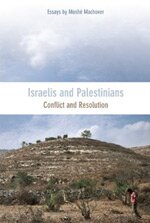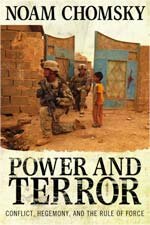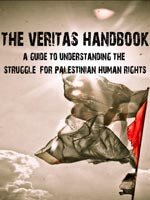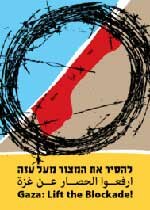B’Tselem – October 2010
www.btselem.org/English/Publications/Summaries/201010_Kept_in_the_Dark.asp
A new joint report exposes routine ill-treatment of Palestinians in Israeli interrogations
The treatment of detainees is one of the tests of human rights protection. Harm to Palestinian residents of the Occupied Territories held in Israeli detention facilities has engaged HaMoked: Center of the Defence of the Individual and B’Tselem since their inception. Over the years, the manner of harm to inmates has changed, partly due to pressure from human rights organizations and international bodies, yet the phenomenon persists.
This report is based on the testimonies of 121 Palestinians who were held, some for up to two months, in the Petach-Tikva interrogation facility of the Israel Security Agency (ISA) in the first and last quarters of 2009. The testimonies indicate clear patterns of treatment of detainees by the authorities. Certain patterns were reported by all detainees, others by most or some of them.
The testimonies show that each time people were arrested from their homes, they were taken in the late-night hours. In 30 percent of the cases, security forces used physical violence toward the detainee during arrest or en route to the detention facility. The detainees related that they were taken in military vehicles; some reported that they were forced to crouch or lie on the floor rather than sit on the bench seat of the vehicle. They were not allowed to bring articles they would need in detention that are allowed under prison regulations, and articles they wore, such as watches, were taken from them.
From the time detainees arrived at the Petach-Tikva facility, they were kept in interrogation rooms or in cells. Almost all the floor space in these tiny cells is taken up by the thin mattress provided to the inmate, or several mattresses in cells intended for several persons. The ceiling is so low an inmate can touch it. Most of the cells are windowless, therefore night and day are indistinguishable. The ventilation was artificial at all times, and 26 percent reported that the air flowing into the cell was either very cold or very hot. The artificial light was kept on around the clock, causing sore eyes, impaired vision and difficulties falling and staying asleep. The walls of the cells are gray and very rough with bumps, and so it is impossible to lean against them. Seventy-eight percent of the detainees were held in isolation in these cells, without the companionship of another inmate, for at least part of their time in the facility.
The hygienic conditions were appalling: the squat toilets in the cells reeked; the mattresses and blankets were filthy; the inmates were not issued materials for cleaning the cells, except in a few solitary instances, following insistent demands; 35 percent of the detainees were not provided with a change of clothes for extended periods and even for the entire duration there; and 27 percent were denied showers. Many reported they had developed skin conditions as a result of their incarceration in the facility.
In the interrogation rooms, the detainees were kept bound to a chair fixed to the floor, preventing nearly all movement. At times, the detainees were kept in this position continuously for hours, with only short food and toilet breaks; in some cases, they were held in the room with being interrogated, and no interrogator was present. Thirteen of the detainees reported sleep deprivation during interrogation, lasting more than 24 hours. Some detainees were interrogated continuously for a stretch of several days, with only short sleep breaks. The detainees reported the conditions in both the cell and the interrogation room damaged their ability to sleep, even without initiated interruption.
Thirty-six percent of the detainees reported that interrogators cursed and verbally abused them; 56 percent reported they were threatened by interrogators, including threats of violence. Ten percent reported being threatened with a “military interrogation”, a vague expression, conceived as a threat of using extremely violent measures. This, despite the fact that, in 2007, the state undertook to desist using this expression, following the previous joint report of HaMoked and B’Tselem. Nine percent of the testifiers related that the interrogators used physical violence against them. Many reported that the interrogators used family members as a means of pressure: In one case, a 63-year-old widow was brought to the facility, apparently so that her incarcerated relatives could witness her anguish in detention. She was released without charge two days later.
42 percent of the detainees were still held in the facility a week or longer after their interrogation ended and in the conditions described, some of them for a month or longer.
The treatment of detainees, as revealed in the report, is consistent with an interrogation doctrine that seeks to break the spirit of the detainee by inducing anxiety and shock, completely removing him from his normal life, and subjecting him to extreme deprivation of sensory stimuli, movement, and human contact. Added to these is the induced enfeebling of the detainee by means of sleep deprivation, food reduction, exposure to cold and heat, and causing pain, mainly through forced stiff postures. This doctrine appeared in the CIA interrogation manuals of the 1960s and 1980s, used, among other things, as guides to interrogators operating in Latin American dictatorships. According to the manuals, these methods result in the mental regression of the detainee, who becomes putty in the interrogator’s hands.
The Israeli authorities sanction such treatment of detainees, as described in the report. Since 2001, 645 interrogee complaints have been made to the Ministry of Justice concerning Israel Security Agency interrogators, but none have led to a criminal investigation. The official Israeli position concerning soldiers’ use of violence during arrest is that such violence is forbidden. However, despite the repeated alerts, the practice is still prevalent, and it seems the soldiers receive mixed messages from their commanders, to say the least.
The measures depicted in the report constitute cruel, inhuman, and degrading treatment, at times amounting to torture. All are prohibited, absolutely and without exception. International law unequivocally stipulates that no state of emergency may be invoked to justify such acts.
In 1999, the Israeli Supreme Court held that ISA interrogators were not authorized to deviate from regular police interrogation practice, which must be conducted in a reasonable and fair manner, without violating the detainee’s dignity. The court nullified a number of interrogation methods used at the time by Israel Security Agency interrogators. The research findings of the present report indicate that, although the ISA interrogation methods changed significantly, it appears the ISA has not accepted the conception, in principle and substance, arising from this landmark judgment that the ISA is subject to the same rules of interrogation as the Israel Police. ISA interrogations are still based on harmful and cruel means – in clear breach of the ordinary rules of interrogation, which are applied in routine police interrogations in Israel.
The State of Israel attempts to justify the severe infringement of detainees’ rights as necessary efforts to thwart severe acts of terrorism. This claim is insufficient to warrant a breach of the absolute prohibition of cruel, inhuman, and degrading treatment and of torture. Furthermore, Israel’s attempts to divert public debate to the commonly known “ticking-bomb dilemma” are artificial, as clearly appears from this report: most of the detainees who gave testimonies for the report were not suspected of serious offenses, and some were only accused of essentially political or religious activity. Also, the fact that the ill-treatment of detainees continued after their interrogation ended refutes the claim that it is only used to thwart acts of terrorism.
HaMoked and B’Tselem propose to examine the authorities’ conduct towards Palestinian detainees in the context of their national identity and their activity against the ongoing occupation, rather than only in the context of the type of life-threatening risk they may pose. The cruel treatment of detainees is possible due to the dehumanization of the Palestinian population in Israel. This perspective offers a better explanation of the practice of ill-treatment than the artificial “ticking-bomb dilemma,” dominating public debate.
The State of Israel must root out all use of such means. This requires taking action that will lead to three indispensable results: stopping human rights violation of detainees, bringing the offenders to justice, and providing compensation to the victims. In addition, it is important to conduct a thorough, independent, and transparent investigation of these ostensible breaches and to publish its findings in full.
READ full report (pdf)






































